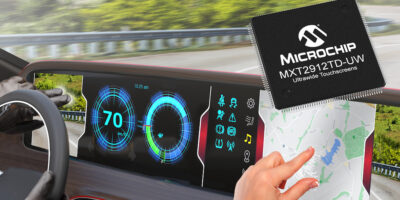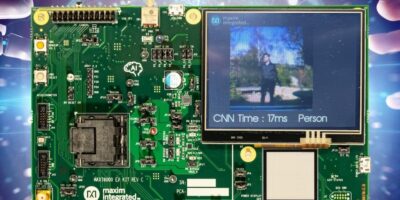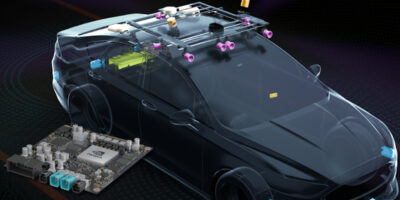Microchip’s maXTouch MXT2912TD-UW touchscreen controller is claimed to reduce integration complexity and cost for wide touch displays up to 45 inches.
Automotive designers are consolidating a vehicle’s cluster, centre stack and co-driver displays into very wide screens to meet the need for safe, intuitive and easy-to-use user interfaces in vehicles.
Microchip claims that the maXTouch MXT2912TD-UW touchscreen controller is the industry’s first automotive-qualified, single chip that addresses display sizes up to 45 inches with a very wide aspect ratio, supporting liquid crystal display (LCD) and organic light emitting diode (OLED) display technologies.
The MXT2912TD-UW reduces the need for multiple touch controllers within a vehicle’s human machine interface (HMI) display. The controller provides the highest report rate for wide displays and is independent of the display resolution, says Microchip, helping achieve the same user experience as the smart phone. The maXTouch family’s intrinsic signal to noise ratio (SNR) enables detection and tracking of multi-finger thick gloves through a variety of overlay materials and thicknesses, even in the presence of moisture, says Microchip.
Safety related features simplify the display module system’s path to ISO26262 functional safety certification. These include periodic self-test, touch sensor test, internal flash and RAM tests, full signal data path integrity checks and additional microprocessor core testing. The embedded firmware is developed to automotive SPICE processes.
To support its touchscreen controllers, Microchip also offers complementary devices such as low dropout regulators (LDOs), 8-, 16- and-32-bit microcontrollers, controller area network (CAN) and CAN physical layer (PHY) controllers.
Software support includes Microchip’s maXTouch Studio development tool and maXTouch Analyzer inspection tool for production line testing. Microchip’s application and support centres provide customer support around the world, including system and sensor simulation/development, integration as well as system tuning. Development hardware and technical support are provided on request.
The MXT2912TD-UW is available in volume production.







